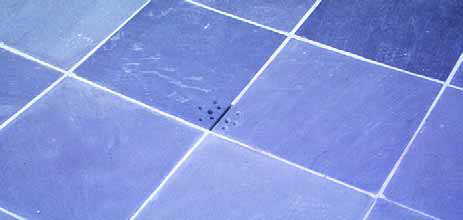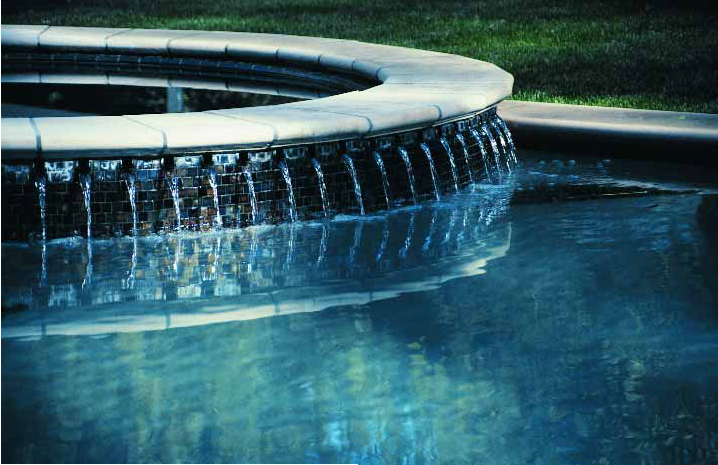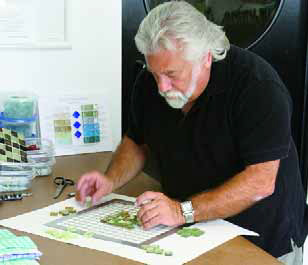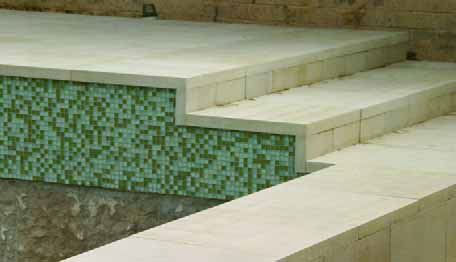Forward Motion

There’s truth to the notion that the only thing that’s permanent in human endeavors is change.
For the past seven years, I’ve had the privilege of sharing with you scores of details, insights, opinions and descriptions of the watershaping process, always hoping that, through words and images, I might influence the way some of you approach your work. It’s been a pleasure throughout, but the time has come for me to change things up, step aside and let other voices take up the cause of excellence in watershaping.
I doubtless could find more to say about what I see as a stratified industry in which custom designers and builders stand on one level creating works of art that are much in demand – and production operations wallow on another, struggling to make headway in a shifting economy. But with the completion last month of a year-long sequence of columns in which I’ve done all I can to pull apart and examine the foundation of my custom-oriented approach to watershaping, I think I’ve said just about all I can for the moment.
Before I step away from the podium, however, I want to revisit a few of the major themes that have been woven throughout this entire sever-year discussion. I’m passionate about these concepts, and as long as people in this industry will listen, I’ll keep speaking up.
FROM THE SOURCE
When you boil it down, everything I’ve ever written in this space has to do with education, aesthetics and proper workmanship and construction.
For my entire career, all I’ve ever really done is apply formal training in industrial design to designing and building swimming pools and spas. When I first entered the industry back in 1979, I didn’t know much of anything about pools beyond the fact that they were intended to hold water and were inclined to be rather ugly when they weren’t being utterly bland and boring.
Unlike so many in the pool industry, I didn’t come up through the service, retail or production ranks and had never been indoctrinated into the industry’s “traditional” ways of thinking. This fact showed in my first experience with a pool-construction company: I’d sought the job out of desperation and was rejected at first because I demanded too much money. But when those with lesser educations and lower financial expectations who’d been hired ahead of me didn’t work out, the company called me back and brought me aboard. (I should have realized right then that the industry was more about doing things inexpensively than it was about doing them well.)
| Disappearing drain covers — January/February 2001 |
Although I was well versed in architecture, art history and the principles of design, early on I wasn’t too clear on the specifics of swimming pools. In other words, I hadn’t learned yet that they were supposed be done cheaply and without much consideration of design.
Suffice it to say, I didn’t last long with that company: The first time I told a client that he should be using something other than white plaster, one of the partners told me to shut up and stay that way. I resigned minutes later and, always loving a challenge, decided to make a go of it with my own company in which I would do things my way. I’ve never looked back.
And that’s where my education came fully into play: When I first sat down to design swimming pools, I couldn’t look at them from the standpoint of what “had always been done” because frankly, I wasn’t aware of the traditions. What I had to rely on instead was my knowledge of spatial balance, line, texture, visual weight, color and myriad other design elements I’d been taught to consider. Happily, I met immediate success in my new business and, much more important, I fell absolutely in love with pools and what I saw them as being capable of becoming – but most certainly not with the industry that produced most of them.
To me, there’s no doubt whatsoever that watershapes of all types and descriptions can and should be wonderful. They embrace an exceptional potential for pleasure and beauty, and all of us who work in this liquid medium have the opportunity to provide our clients with works of art that yield years of enjoyment. To unlock that potential, however, we must abandon the idea that standard methods, products and approaches are somehow sacred and sufficient.
WORTHY PURSUITS
From the start, I also based my business on a quote from Ernest Hemingway: “Anything that was ever any good, you pay for.”
That thought is important for two reasons: First, it carries the concept of building value into the product – something that has not been a universal priority for the pool industry. Second is the notion that in making that valuable object, you need to offer it for a price befitting that value. This isn’t to say that every body of water we create has to be priced way up in the six figures; instead, it means there’s a relationship between the value of what we create and what we’re paid for creating it. It also means that value and success always go hand in hand – and always will.
In my view, breaking through the constraints of “traditional industry thinking” can only happen when the work we do is informed by training in design, art and architectural history, engineering and proper construction practices. To maximize the wonderful potential of watershaping, in other words, we must all understand the principles of design while also at least speaking the language of artisans who apply their skills in the concrete, plumbing, steel and finish trades.
| ‘Tishways’ spillover system — January 2002 |
As I mentioned above, I fell in love with all of these processes. I’ve kept my eyes open, designed some products (including Jandy’s One Touch and Oreq’s Tishways), learned how to execute new design details on every project (and developed a few of my own, including neck ledges, new approaches to color blends with tile and new ways of looking at plaster colors) and amassed an ever-expanding understanding of the construction side of things as my confidence and repertoire have grown. And I’m certain that as long as I’m working in this field, I will continue to learn and understand more and more.
As I mentioned above, however, I was long on design education and short on practical construction knowledge when I started my company. To address that gap, I made it my business to learn as much as I could about the trades I was directing. I tied steel, built forms, laid plumbing, drove a backhoe, applied shotcrete and set stones, picking up all I could about these crafts. Along the way, I also learned the value of working with the best of all available subcontractors.
As I’ve mentioned countless times in these columns, the crews I work with are like family to me. Most have been with me for more than 20 years, and many of them now travel with me all over the country and even overseas to execute my projects. I know deep down that I couldn’t design the way I do without the information I’ve gleaned from them through the years, nor could I build projects that stretch the boundaries of design without being able to rely on their attention to detail and quality.
Their skills enabled me to press the creative limits I encountered when I started my company. Ultimately, they helped me become known for building reliable structures off the sides of mountains and for devising swimming pools that exist in the realm of architectural art. And none of this would have happened without my years of study and pursuit of relevant practical experience.
A DIFFERENT APPROACH
This marriage of aesthetic and technical skill resides at the heart of all great watershaping projects, and my desire to spread the word (and share the resulting wealth) is a big part of why I participated with my friends Skip Phillips and Brian Van Bower in starting the organization known as the Genesis 3 Design Group.
I won’t speak for Skip or Brian, but somewhere deep inside I was also motivated to establish this unique educational entity because I felt a need to respond creatively to the challenge carried in another of my favorite quotes, this one from a member of my own industry: “Why would you ever want to learn about Frank Lloyd Wright? He’s dead.”
Hearing that statement was a signal moment for me and is largely responsible for the aggressive ways in which I’ve pressed my pro-education agenda in the years ever since. This one clueless builder (and, in their own ways, others too numerous to mention here) taught me in a flash that, back in those bad old days, the mainstream pool industry was in the business of creating exterior environments without giving a tinker’s damn about the architectural contexts in which they were being placed.
| Custom tile-blending — December 2005 |
Moreover, there was no interest in the lessons to be learned from the masters of the architectural arts in which we supposedly were participants. To me, it was unfathomable then (as now) that anyone could even begin to design a pool or fountain without understanding the principles that defined the greatness of individuals such as Wright or John Lautner or Louis Sullivan or Richard Neutra or of design groups such as Archigram.
It was this information gap that made the idea of establishing educational programs that could advance the industry so attractive to me.
In the ten years since we ran our first school, I’ve always been gratified by the response to our programs and by seeing how they have influenced people in this industry to reach for the stars. And truth be told, that reach involves some simple steps, such as dignifying the process by charging for design work; offering professional presentations; and leaving clients with a choice having to do with something other than price. But I can’t say that this progress has come as a huge surprise, because I’ve always known just how powerful education can be in helping people see into realms of greater possibility, and just as important, in letting them know how to turn big ideas into realities.
As things stand today, Genesis 3 may be the only resource in this industry for such education, but my hope is that this will change someday and that, finally, watershaping will be part of the formal design curriculum for architects and landscape architects and that classes in water-related design and construction will take root in major colleges and universities. Until then, I’m proud of the trail we’ve blazed, very proud to have advanced the industry and happy to see so many people come to the conclusion that education reshapes and transforms the ways they think about what they do.
COURSE BY COURSE
In developing courses for the Genesis 3 programs and establishing the parameters for membership in the Society of Watershape Designers, we’ve always seen the need for three separate tracks – an ABC approach encompassing Aesthetics, Business and Construction. So far, we’ve focused on A and C; someday, we’ll get to B as well.
My great, personal passion has always, always been on the Aesthetic piece of the puzzle and design education, basically because I’ve seen it as the most direct, positive, productive way I can respond to the question of why we should care about Frank Lloyd Wright. And if you pool guys need any more motivation to pay attention, bear in mind that architects and landscape architects already “get it” and are increasingly seeking education through Genesis 3 and the Society of Watershape Designers that gives them specific insights into issues that drive the pool industry. Often, they’re motivated to crack the books by dissatisfaction with the performance of pool builders; just as often, they’re captivated by what they see as a ready way to generate revenues.
What those professionals have that lots of pool builders lack is just the sort of information Genesis 3 offers in its four core design classes – on art history, design, color theory and drawing.
[ ] The History of Water in Architecture is taught by Mark Holden, a talented landscape architect and watershaper whose work should be familiar to readers of this magazine. To my way of thinking, this course is radically important because it helps participants place their work in the context of the history of art and architecture rather than within the mindless “traditional industry thinking” that has limited pool design and execution for generations.When you walk into a home and see a Rothko proudly on display or something by Matisse or Seurat or Miro or Picasso, you know a good bit about a client’s tastes and personal style without having to ask any questions at all. This course, in other words, gives you by extension a vocabulary that allows you to converse easily and intelligently with clients about what they’d like to see in their backyards.
As a practical example, in many of my designs I raise the edges of pools out of the ground. It’s a detail I’ve borrowed directly and shamelessly from baths built in Turkey by Hadrian, a Roman emperor who lived nearly 2,000 years ago. It’s not an original idea, but my familiarity with this tiny slice of art history enables me to recycle it whenever it’s appropriate and to speak about what I’m doing in terms that both dignify and clarify the design/build process for my clients.
[ ] Elements of Design is taught by my New Jersey-based partner Kevin Fleming and by top-notch designer/builder Steve Wilson of Houston – well-educated professionals who have spent years absorbing the nuances of working with texture, balance, line, proportion and scale. This is fundamental information that liberates watershapers to create pools that fit seamlessly within their contexts and helps them avoid the folly of thinking in terms of freeform blobs with heaps of rock at one end.When you visit someone’s home armed with the knowledge of why spaces look and work the way they do, you can recognize design elements in the structure and décor and perceive what your clients are most likely to expect and accept. Too many pools I see bear no relationship whatsoever to their surroundings and show no evidence that the person who pieced the design together had the slightest idea of just how inappropriate their work would be as a design solution for the space at hand.
It’s appalling that salespeople still get away with walking onto a site, pulling out a template and doing all they can to persuade a client that what they’re holding is magically suitable either to the site or the home’s architecture. If you want to get away from that abominable approach, this course offers valuable insights into the process of shaping and positioning watershapes and establishing settings in which line, scale and balance work together.
[ ] Color Theory & Design Application is taught by Judith Corona, an instructor at Otis College of Art & Design and UCLA, a fellow of the Whitney Museum in New York and one of the premier colorists in the United States. In this course, she introduces participants to the profound and often dramatic ways in which colors influence people’s reactions and relate to their basic feelings about built spaces.Many people I’ve run into raise their eyebrows at the inclusion of this course in our curriculum, but as I see it, understanding color theory and becoming aware of how it can be used is the key to creating designs that make deliberate, purposeful artistic statements. This is an all-new set of information for the traditional pool industry, but it’s this sort of insight that’s led me through the years to design some of my most visually effective projects – including the notorious Red Pool as well as a range of less-controversial (but no less striking) green pools.
[ ] Design Communication: Measured Perspective is led by Larry Drasin, a peerless industrial designer, and Milt Dorsey, an amazingly gifted graphic artist, who use their years of experience as instructors at UCLA in teaming up to teach participants how hand-drawn illustrations can be used to get messages across to clients as well as contractors, subcontractors, crews and suppliers.Yes, we’re now surrounded by technology that helps those who don’t know how to draw, but whether you’re doing hand renderings or using CAD, you still need to know about the basics of visual representation to be certain you’re accurately representing to others what you picture in your mind. And think about it: What good are fantastic CAD skills when you’re seated at a client’s kitchen table trying to explain exactly how key design elements will look and work together? How much time does that take with a pencil and paper compared to a computer?
This is, quite simply, a wonderful course that opens eyes not only to the value of drawing skills, but also to the importance of a basic understanding of the processes and parameters of design.
CONSTRUCTIVE LEARNING
From the beginning, our ambition with these four core courses was to give participants a sense of what formal training in design is all about. Each takes 20 hours to complete (and there’s a test or practicum at the end of each that must be passed to gain credit toward membership in the Society of Watershape Designers), but in every case, these courses are designed not as ends in themselves, but as keys to unlock doors that lead to a lifetime of ongoing, continuing education, study and pursuit of knowledge and insight.
Another huge educational component of the SWD program has to do with construction – the execution side of the design process. To us in Genesis 3, this is just as important as developing skills on the design side, because creativity is severely limited when you lack knowledge of how things are built.
| ‘Effortless’ material transitions — October 2006 |
I won’t go into this side of the course work in detail here (don’t want to overstay my welcome!), but suffice it to say that I’m a radically firm believer in the fact that understanding such diverse disciplines as geology, structural engineering, materials science, workmanship and hydraulics is the key to making design knowledge worthwhile. (A tip of the hat here to Skip Phillips, who has taught me just about everything I know about hydraulic systems and how they work in the real world. He’s the driving force behind the Construction Schools we’ve developed.)
I also firmly believe that designers and builders are complementary creatures: What is designed must be understood to be built, and to build it, one needs to understand the essence of the design. Everything, in other words, goes hand in hand: As watershapers, we must be able to work with both the left and right sides of our brains and fluidly integrate the aesthetic with the practical, the art with the engineering, the imagined with the real.
What encourages me more than anything else (and lets me set aside this column without tremendous pangs of guilt) is that there are already many professionals in this industry who have successfully undertaken the journey I’ve been recommending for so long. And what they all have in common, no matter their backgrounds, is a shared belief in the value of education.
I’ve beaten this drum in my monthly WaterShapes column for seven years now and will leave you here with one last thought: If you want to step up, it’s time to get off your butt and get moving. If you see doing things the way they’ve always been done, good luck. If you don’t, I’ll be seeing you – and soon.
David Tisherman is the principal in two design/construction firms: David Tisherman’s Visuals of Manhattan Beach, Calif., and Liquid Design of Cherry Hill, N.J. He can be reached at [email protected]. He is also an instructor for Artistic Resources & Training (ART); for information on ART’s classes, visit www.theartofwater.com.














